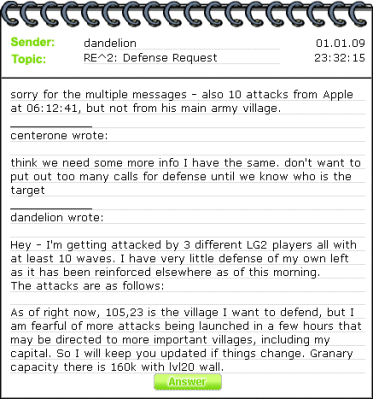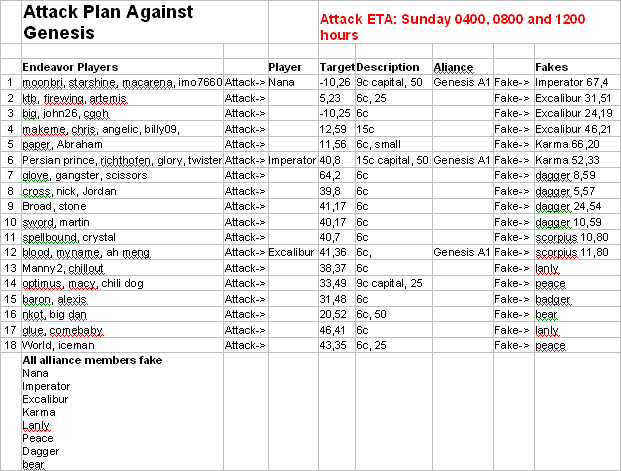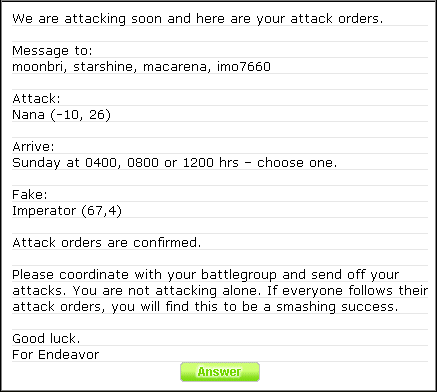If you want your alliance to win, it is vital to have an active and aggressive offense coordinator.
Too many alliances lack aggressiveness. They continue to tuck their tails and defend and ask for reinforcements when they are under attack. But when the enemy attacks ten of your players in several different villages – then who do you defend?
Case in point is the message below:-

As you can see in the message : “think we need some more info I have the same. don’t want to put out too many calls for defense until we know who is the target”
The question is, how can you tell who is the target?
As mentioned under the Defense Coordinator section, defending against attacks is very much guesswork. If an alliance continues to hold onto the believe of defense, slowly one by one of your players will be eliminated.
The best thing to do is to attack. Attack, and attack, and attack.
Organizing an alliance attack is not difficult. Actually, it is easy and simple to do, especially when I have outlined the steps in the next section. But it is a time consuming task.
The main problem is finding a player who is willing to put in the time to organize attacks. Your offensive coordinator should constantly plan and organize attacks. The moment troops have returned home, its time to send them out to attack again.
As an alliance leader, don’t underestimate the importance of your offensive coordinator. Appoint your most aggressive and most active player as your offensive coordinator. He very much holds the key to your alliance strength.
As an offense coordinator, when planning any attack, you need to understand that not all of your players will attack. So if you assigned ten targets, expect only half, or in best cases, only 80 or 90 percent of your players to attack.
A good strategy is to assign more targets. So if you wanted ten villages dead, then assign 20 targets. Expecting only half of them to attack, then you would have reached your goal anyway.
Every alliance has several offensive strategies that can be used. The success of these strategies depend very much on teamwork and coordination. Better alliances have a high level of teamwork.
Faking is also very important and must be included with any kind of attack.
A few of the strategies are discussed here.
Achilles Heel
What is the most crucial position in an alliance and the Achilles heel of every Alliance? Eliminating this player is like removing the supporting pillar in your enemy alliance.
The Offense Coordinator is the Achilles heel of an alliance. Make sure you get rid of this person in your enemy alliance, and protect your own Offense Coordinator. Once removed, you can expect attacks against you to wind down.
I was a very active Offense Coordinator who constantly planned and issued attack orders for my alliance. All was going fine and well, my alliance was slowly crushing the enemy alliance. Until I came under a barrage of attacks myself.
I had been targeted and this forced me to go onto the defense, sucking up all my time for defense, I had no time to plan attacks. Eventually, I became demoralized due to the constant attacks that made Travian no longer enjoyable, and I almost quit. But my love for my alliance made me hang on, but I had stopped organizing attacks.
Although we looked for another Offense Coordinator, none were as active as me. This made me realize it is tough indeed finding a good Offense Coordinator.
But more importantly, I realized that the Offense Coordinator was the key person to target and destroy. Had I not been targeted, and if left alone to plan attacks, the other alliance would have completely collapsed under my attacks.
Therefore, always seek to remove your enemy’s Offense Coordinator. After he has been removed, target the alliance head. Some players are very difficult to remove. Eventhough under heavy and constant attacks, they stubbornly refuse to delete. If that happens, then its best to just move on and target the next person in line.
Protect your own Offense Coordinator, and if possible, keep his identity a secret.
Battlegroups
At the core of your alliance fighting unit is the battlegroup. It uses the concept of hammer and wingman. Before organizing an attack against an enemy alliance, you need to organize your alliance into groups of hammer and wingman.

A hammer is a player with a large offensive army. His role is to clean the enemy’s village, and then attack with whatever catas he has. However the amount of damage a hammer can inflict is limited by the number of catas he has.
A wingman is another player who follows behind the hammer. He does not need to have a large offensive army, but he should some catas to be able to deal further damage. A wingman must be able to carry out precision attacks, so his attacks land behind the hammer everywhere.
Operating in teams of two, a hammer-wingman formation will be able to deal double, triple or quadruple the amount of damage than operating alone. A hammer may also have more than one wingman following him.
Therefore, a battlegroup consists of one hammer and one or more wingman.
Organize your alliance and list down all your hammers. You should know who your hammers are, as they are the players with large armies. Then ask each hammer to choose between one to three players as their wingman. Record the teams so they form a battlegroup.
It is better to let the hammers choose their wingman because they know their neighboring players better than you do. Also, they will be able to team up with their friends and favorite players – an important part that will help improve coordination.
Once battlegroups are formed, assign targets by battlegroups. Communicate the target and arrival time to the hammer. Let the hammer work with his wingman and the entire team attacks as a group. Faking needs to be done too, but generally, the rule of thumb is attack one, fake one or two.
With enough battlegroups participating in attacks, this is an extremely deadly offensive strategy which I have used with great success. It was so successful that the enemy quickly learnt and used this strategy back at me, but their level of coordination was low due to a lack of experience in forming battlegroups.
The setback with this method is the members of a battlegroup needs a high level of discipline to attack as a team. Most players lack this discipline, so it only works with alliances that have good coordination and teamplay. This very much depends on the quality of your players, but all top alliances have at least some good players.
Capital Attack
In a capital attack strategy, only a handful of players are selected to participate. It can be as few as one player to as many as you wish, but the main requirement is a large offensive army with a decent number of catas (at least 400).
Due to the large number of catas required, this can be used only from mid game onwards.
Each player will send 4 or 5 waves of cata attacks to the capitals of at least seven players (ie one real, six fakes). The real attack should have at least 100 catas in each wave, all targeting the croplands. The maximum possible damage is ten croplands destroyed (5 waves x 2 croplands).
High level croplands are very expensive, and another reason why it would be feasible only from mid game onwards is because in the early game, players do not have croplands above level 15.
It is important for all the four (or five) attack waves to land on the same second, otherwise the enemy will just snipe your attacks. Even the fake attacks must land on the same second or it is easy to spot the real attacks.
So if you don’t get your attack sent off correctly, you need to cancel them and resend, until all four waves land on the same second. This is troublesome, but necessary.
The capital attack strategy can be quite risky and you may lose your hammer, especially if you attack top players. I managed to kill many enemy hammers who attacked my capital – which was how I ended in the top defender ranks of the server. I also witnessed many large hammers wiped out because they attacked the capitals of top players.
This strategy is best used against medium players. Fake the top players, and attack the medium players. Although there is still a risk, but it gives you more mileage and on average, you will destroy many, many capitals before your hammer is finally wiped out.
Faking needs to be done too, and other alliance members can be asked to send random fakes.
In summary, the Capital Attack strategy involves :-
- Select only a handful of players to participate. They must have large hammers with catas.
- Assign each of them to attack one enemy capital village. If there are three attackers, then they should attack three different capitals. Send 5 five cata waves, aim for croplands. Avoid top players, target medium players.
- Get each of them to fake six other enemy capital villages with five cata waves each. Favorite fake targets are top players and alliance leaders.
- Ask the other alliance members to randomly send fakes to capitals only.
Use this strategy, especially in the mid game, and a lot of players’ capitals will be dead.
Rain of Fire (RoF)

Involves many (if not all) players within an alliance to use their secondary armies to attack an enemy alliance. Before RoF can be used, players must first be instructed to build a RoF army. A RoF army should at minimum consist of 1000 axeman, 500 TKs, 100 rams, and 110 catas.
Players should be instructed to build RoF armies sometime during mid game.
Once players have a RoF army, they can be assigned to attack a player’s village at random. There is only one attack wave in a RoF attack, so only two buildings may be destroyed. The best targets are the Warehouse, Granary, Trade Office, Main Building or Marketplace.
With a RoF attack, fake all the other villages including the capital. Avoid attacking the capital with a RoF army as they are too small.
Players can be assigned targets by alliance rank. For example, the number one ranked player within your alliance will attack the number one ranked player in the enemy alliance. The number two will attack number two and so on.
This however, is not a very creative target assignment because the attack pattern is easily recognized. A clever commander can defend against such attacks by assigning same ranked players from friendly wings to reinforce those under attack.
You may also assign RoF targets by letting players choose their own targets. They may be assigned to attack any village of the top 15 players in one or two wings of the enemy alliance. This attack pattern is somewhat more difficult to spot.
RoF attacks are simple to organize, and can be very useful, and provided that players actually send fakes, then it is very difficult to defend against them. You will find that if executed well, RoF will have up to 90 percent success rate.
The key for RoF success lies in faking and having a lot of players attacking. If there are not enough fakes, this strategy will have a high failure rate.
The setback of RoF attacks is that it does minimal damage and is only disruptive at best.
In summary, the Rain of Fire strategy involves :-
- Get all players to build a RoF army.
- Assign every player to send a single wave cata attack to the top 15 players of an enemy alliance. Avoid the capital, aim for support villages.
- Fake every other village, including the capital with a single cata wave.
Fake Attacks
Faking should be included in any kind of attack, whether attacking alone, in groups or in a coordinated alliance strike.
Fakes must always include the capital. It confuses the enemy as to the real target, and it forces the defender to spread his defenses to a few villages. Don’t underestimate the value of sending fakes.
Fakes can also be used as a psychological tool or to send a warning to someone. Some players are not used to fakes, and are easily frightened to see all their villages under attack. Constant fakes can also demoralize a player to the extent that the game is no longer enjoyable which will result in him quitting the game.
Of course the more seasoned players are immune to any number of fakes they receive.
If possible, players should always use catas and send multiple waves of fake attacks. If this is too expensive, then the next best unit is the ram. The quality of fakes drops considerably if faster units are used, such as the axeman, praetorian or swordsman. The faster the unit, the easier it is to spot a fake. The further the travel distance, the easier it is to spot a fake. Encourage your players to send catas or rams, but don’t enforce this because any kind of unit is better than not sending at all.
The setback with fakes is not many players will actually comply with fake requests. Some are afraid of being attacked as a result of faking, but also because sending fakes is really boring.
The Delayed Attack
The Delayed Attack is a very potent strategy that will throw your enemy defenses off their foot.
This strategy requires you to time three attack waves spaced about 15 hours apart. Having formed your battlegroups, select three enemy players and ask your battlegroups to send cata fakes at their capitals. Make sure you select important enemy players, those at the top of their ranks, otherwise the enemy alliance might not bother to defend a player with just five or six villages.
To make the attack look threatening, select at least five players to conduct the fake attacks. Time the attacks to arrive right on the dot, so they look like a planned attack. So the first attack wave might for example arrive on Monday morning at 1100 hours.
This will cause the alliance to send defenses to the three players under attack.
Then send a second wave of cata fakes to the capitals of another three players. As before, at least five players need to send their fakes to arrive on the dot about about 15 hours later – so they arrive on Tuesday 0200 hours. By the time the first three players realizes their attacks are a fake, they would send back their reinforcements and then rush them to the new targets.
Many defenders will not be able to make it in time.
Lastly in your third wave, you would send off the real attacks. Select three enemy players again (maybe even one of the players in the first original list) and send off a real attack to his capital. The attack should arrive about 10 hours later (either timed to the dot, or not).
There’s a high chance the player in the first list will not be defended because the first attacks on him turned out to be a fake afterall. This gives you an excellent chance of success.
All fakes should be conducted with multi cata waves, at least 4 waves landing on the same second.
This seesawing of attacks camouflages the real targets and as mentioned, many defenders will be enroute to and from their destinations, that most will not be able to make it in time for the real attack on the third wave.
After a while, the enemy will pick up on your attack pattern. To maintain its potency, add in a variation to your strategy. Use three waves, at other times two waves. And at other times, hit a non-capital instead.
Organizing Your Attack
It is better to concentrate fire on a handful of players so you may eliminate them, than to spread your attacks on a lot of players and cause minimal damage to each.
Begin by selecting two or three players to eliminate. Target their capitals and a few of their support village. Then select where and whom to fake. If your attacks are successful, you will find that most players will actually quit. Rinse and repeat – that is how you win alliance wars.
First create a spreadsheet to plan your attacks. Here is an actual attack plan I used with great success. All names have been modified for anonymity.

In the attack plan above, 45 players are involved and they are organized into 18 battlegroups. Remember that this is an actual attack plan, only their names have been changed.
Sending igms to 45 members can be very time consuming, so you may send to the battlegroup leader (hammer) and let them coordinate among themselves.
Only three players were chosen to be eliminated and a total of nine players were faked. Strong hammers are assigned to attack capitals.
Choose the attack arrival times. I provided three attack times – Sunday at 0400, 0800 or 1200 hours. Not everybody can attack at a given time. Providing multiple arrival times will ensure more players are able to join in the attacks.
Depending on the distance, attack orders for the battlegroups need to be sent about 36 to 48 hours in advance, to allow them enough time to plan and organize their attacks.
About 24 hours before the actual attack, send out a MM to all wings to randomly fake the remaining players in the list. Fakes can arrive at any time.
If you feel like doing it, you may also ask the remaining alliance members to send RoF attacks at the fake list.
Here is a sample of my actual attack igm:

The setback is, no matter how well planned, not all players will attack. You have to factor and accept this. But of the remaining players who do attack, you will find that this is still a very effective plan.
The other setback is, it takes a lot of time to organize attacks – to the point that it affects your own raiding and growth potential. That’s why having a co-player to manage your account helps a lot.
Resource Denial
Resource Denial is a simple strategy to deny farming resources to your enemy alliances.
There is no doubt that in every alliance, players are regularly farming inactive players.
Look around the map in the area of your enemy alliance. And with the help of the Travian World analyzer, you will be able to spot inactive players dotted around the landscape.
If you’ve missed it, the Travian World Analyzer is here:-
You can also find out who are your enemy alliance’s farms by using spies to access their battle reports.
Once their farms have been identified, organize an attack to destroy these farms. Attack only inactive farms. And because you are attacking inactive players, the risk is very, very minimal.
Send attacks to aim for their warehouses and granaries. That will be good enough to deny farming resources to your enemies. Additionally, these inactive players will be conquered sooner or later. By destroying these inactive players, you are also reducing the abundance of ripe villages for conquer.
Resource denial is best carried out between the early to mid game onwards.
